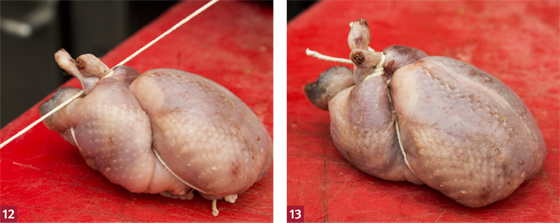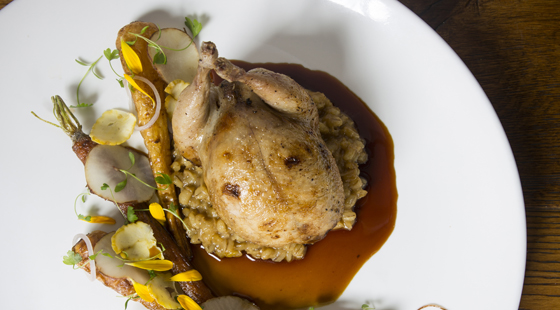Masterclass: Stuffed boned quail and barley risotto by Richard Bainbridge
Small of size but big in flavour, quail is served at Benedicts in Norwich by chef-patron Richard Bainbridge. Accompanied by barley risotto, his stuffed, boned and reshaped quail dish puts a whole roast bird on a plate in diner-friendly form. Michael Raffael explains.
Plenty of chefs use quail eggs in their kitchens, but not too many use quails. In their wild state, these birds, which are smaller than a poussin, aren't native to the UK, and on the continent they are an endangered species. A few poultry farms in northern Provence still rear them for the table.
Norfolk Quail (www.norfolkquail.co.uk), a poultry farm near Fakenham, Norfolk, rears conservation-grade birds. What started as a spin-off from eggs has grown into a business supplying birds to, among others, Belmond Le Manoir aux Quat'Saisons in Oxfordshire, the Black Swan at Oldstead in North Yorkshire, and Benedicts in Norwich, which is owned by chef Richard Bainbridge.
Quail is reared for 10 to 12 weeks and its taste is distinct from chicken without being gamey. That flavour is down to the way the birds are processed. After slaughter by gassing, the quail are not bled as happens with, say, poussins; instead, they are dry-plucked and then waxed to remove any remaining plumage without damaging the skin. The intestines and stomach are removed, but the liver and heart are left inside.
By boning, stuffing and re-forming quail, Bainbridge delivers a whole roast bird on the plate that is easy for the customer to handle.
Planning
- The pearl barley for the risotto base is soaked overnight.
- The quail is boned, stuffed and trussed in batch sizes of 12-18 daily.
- The quail is roasted, the risotto finished, the vegetables roasted and the sauce finished to order.
Costing
Benedicts serves two courses for £29 and three courses for £37 from its à la carte menu. Each quail costs £3 plus the costs for the stuffing, vegetables and sauce.
To prepare the quail Boning
Cut off the winglets (1). Scrape around the wishbone and pull it out (2).
Turn the quail over and cut along the backbone from stem to stern (3). Dislocate the thigh bones where they slot into the carcass (this will make boning easier) (4). Being careful not to damage the meat or skin, separate it all from the carcass (5). Cut through the wing joint on one side and work back to the leg. Keep the knife point held against the carcass and use your fingers to follow the shape of the bone. Repeat the operation with the other side of the quail.
Separate the skin that is still attached to the keel-bone and free the quail from the carcass. Scrape round the thigh bones to expose them and then cut them off at the joints with the drumsticks. Remove the wings, taking care not to damage the skin. (6).
Stuffing
(7).
Trussing
There are two stages to re-forming the quail: the first is to bring the two halves of the bird together and then stitch them up with kitchen string (8); the second stage is to truss it â¨without using a needle (9).
Thread a trussing needle with about 50cm of string. Tie a knot 15cm from one end that will be large enough to stop the string going through the skin.
Lay the bird skin-side down, with the neck end towards you. Pull the halves together and stitch them up. When you reach the end, you will still have a length of string. Unthread the needle and put the string under the parsonâs nose, then take it back and fasten it to the end where the knot is (10).
Turn the quail on its back. Take a second piece of kitchen string (also about 50cm long). Lay the string under the thick end of the breast where the wings were (11). Now bring both ends back up and over the skin between the legs and breast (12).
Cross over the string using the parsonâs nose as a guide. Take the two ends under the drumsticks and back over them. Tie the two drumsticks together (13).
To make the barley risotto base
Benedicts will typically work with a batch size based on 1kg of pearl barley from Crisp â¨Malting Group (www.crispmalt.co), which is soaked overnight; the recipe here uses 200g.
Note: the precise amount of stock will vary according to the surface area of the pan and the speed at which the barley absorbs the â¨liquid. Itâs better to choose a pan with a large surface area (eg a large sauté pan).
200g pearl barley, soaked overnight
30g rendered lard
120g shredded leek
250ml dry white wine
1 litre (approximate) brown chicken and â¨vegetable stock (see panel above)
Heat the lard and sweat the leeks rapidly, turning them over in the pan until they are soft â" about three minutes. Add the soaked barley and mix it in well with the leeks (14). Pour in the wine and boil hard until it evaporates. Pour in all the stock and let the barley boil gently until tender (15). The basic ârisottoâ will still â¨be moist. Empty it into a container and chill â¨rapidly ahead of service.
Stuffed boned quail with barley risotto Serves one For the vegetables
2 scrubbed (not peeled) small carrots
2 scrubbed (not peeled) small parsnips
40g-50g salted butter
For the quail
20g lard
1 stuffed quail
Salt and white pepper
30g butter
For the barley risotto
100g (approximate) risotto base
1tbs (heaped) Parmesan
15g butter
To finish: slices of raw Jerusalem artichoke, chestnut and shallot with a squeeze of â¨lemon juice on them and celery cress
1 jug chicken/quail gravy (see panel above)
Sauté the carrots and parsnips in butter in â¨separate pans until they start to colour (16). Transfer them to a moderately hot oven at 190°C to finish roasting â" about 20 minutes.
Heat the lard in a sauté pan. Season the quail with salt and colour it on all sides. Add the butter and baste thoroughly (17). Transfer to a 180°C convection oven and roast for about eight minutes (18). Rest and sprinkle a little white pepper over the skin just before serving.
Reheat the pearl barley in a small pan. Stir in the butter and cheese. Donât let the mixture boil.
Turn the quail on its side and cut through the string used for stitching. Pull it out. â¨Cut through the trussing string.
Spoon the pearl barley onto a plate â" it should just hold its shape. Stand the quail on top of it, arrange the roasted carrots and â¨parsnips to one side, and sprinkle the raw â¨vegetables and cress on top (19).
Accompany with a jug of gravy.
Sausage meat stuffing Benedicts prepares batches based on a kiloâ¨of sausage meat, but the quantities given here have been scaled back to 250g.
Combine 250g of sausage meat with 150g of diced back fat, a tablespoon of diced chicken livers, 15g of sweated garlic and shallots, a heaped teaspoon of Dijon mustard, 75g of plum or other home-made chutney, a dessertspoon of chopped herbs (chervil, tarragon and parsley) and seasoning.
Brown chicken and vegetable stock
Benedicts makes a vegetable-heavy chicken stock, as vegetables figure strongly in many of its dishes. For every kilo of browned chicken bones, brown 300g of carrot and onion separately. Combine the two and add â¨a stick of celery and a bundle of parsley stalks. Cover with twice the quantity of â¨water and bring to the boil. Skim and â¨simmer for two hours, and then strain.
Quail gravy
This is part of the kitchenâs basic mise en place. The quail bones â¨and carcasses are mixed with the chicken bones.
Fry a kilo of bones in a little lard until golden and then transfer â¨them to a large boiling pan. Fry four chopped shallots, two chopped carrots, three garlic cloves and three sticks of celery in the same fat. Deglaze with white wine.
Add the fried veg to the pan with the bones and pour in more â¨wine (one litre altogether). Boil and then reduce by three-quarters. â¨Add two litres of the basic brown chicken and vegetable stock and â¨two litres of veal stock. Boil and skim. Add a large sprig of thyme â¨and two bay leaves. Cook out for 45 minutes and strain through muslin. Reduce to a concentrated demi-glaze.
For each serving, heat 100ml of the sauce base and finish with â¨a splash of wine and a small knob of butter.
Richard Bainbridge
As an ambitious young chef at â¨the start of the noughties, Richard Bainbridge spent three-and-a-half years at the Waterside Inn in Bray, Berkshire. Every day, he recalls, Michel Roux did the rounds and shook hands with members of the 25-strong brigade. âIt was two years before Mr Roux, like a god, put his hand on my shoulder and said: âGood morning, Richard.â It was one of best moments in my career.â
That building block in Bainbridgeâs professional career taught him the foundation of classical cuisine and has served him well ever since. â¨His other major influence has been Galton Blackiston at Morston Hall, where he worked as head chef before opening Benedicts in Norwich two years ago.
Between times he worked in â¨the US, Australia and New Zealand. â¨His management of the demanding front of house for a Hawkes Bay restaurant on North Island changed him. âI knew I wasnât ever going â¨to be one of those shouty chefs who create a barrier between the kitchen and waiting staff,â he says.
âMistakes are bound to happen, both in the kitchen and out front, but you have to get through the errors together.â
Another insight from that time is: âMr Roux taught me a restaurant isnât about the kitchen. Itâs â¨about the couple sitting at a table enjoying each otherâs company.â
As the 2017 guest judge on â¨the Great British Menu, he knows the competition with all the pitfalls it can bring to wannabe TV chefs. Looking back on the first of his â¨four appearances on the show â¨(he served the recipe opposite on his last attempt in 2015), he says: âYoung chefs are so giddy with what they can or think they can â¨do. They want to put all the skills that are in their heads on a plate. â¨I wanted to show off; it was my chance to shine. I wanted to be â¨on the telly â" and I messed up.â
Three attempts later he won with two dishes â" a starter andâ¨a dessert â" served at the banquet to celebrate 100 years of the Womenâs Institute. âIt was my last hurrah,â he reasoned. âI thought, this time Iâm going to cook my food, be who I am and do it in my style. Iâm not going to play up to the â¨TV or the other chefs.â
It was a formula that paid â¨off, and itâs how he cooks for his customers at Benedicts. âEvery day, I tell the guys to imagine that their mums, girlfriends or whoever are up there,â he says. âThey â¨donât have to create some kind â¨of persona, just be themselves.â























